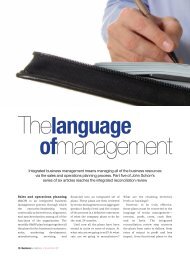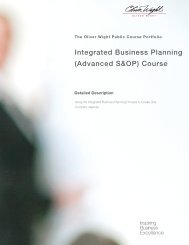Oliver Wight Caterpillar NACD Case - Oliver Wight Americas
Oliver Wight Caterpillar NACD Case - Oliver Wight Americas
Oliver Wight Caterpillar NACD Case - Oliver Wight Americas
You also want an ePaper? Increase the reach of your titles
YUMPU automatically turns print PDFs into web optimized ePapers that Google loves.
Skurla agrees. “The S&OP process contributed to less variability in the process,”<br />
he said. “The environment encouraged management teams to make changes<br />
as soon as they were aware of new information, instead of holding on to a<br />
business plan too long. As a direct result, adjustments fell within a more<br />
reasonable range and the division avoided major inventory bubbles for the<br />
plants to deal with.”<br />
The <strong>Caterpillar</strong> team saw outside consultants as catalysts for the actions they<br />
undertook. “In the early days of the S&OP implementation, it was critical to<br />
have a third party present, particularly when marketing and plant personnel<br />
disagreed,” Roberts said. “It was helpful to have an objective third party who<br />
could broker the ideas and be objective. Pete would sometimes pitch our ideas<br />
back to us and tell us where we’d gone wrong. That’s harder for an internal<br />
group to do. Their objectivity and experience was quite helpful.”<br />
Bringing the Dealers into the Process<br />
Using Sales & Operations Planning to achieve better alignment within CAT was<br />
only half the story. Another payoff would come through improving dealer input,<br />
increasing dealer alignment and reducing dealer inventories.<br />
Many dealers and personnel from <strong>NACD</strong> districts hold monthly meetings to<br />
formulate their request for product. Adjustments are encouraged, not discouraged.<br />
Plant schedulers are now better able to take a ‘pulse’ of the market and to refine<br />
their plans. Terry Powell, Scheduling and Order Entry Manager for <strong>Caterpillar</strong>’s<br />
Track Type Tractor Division (<strong>NACD</strong>’s largest internal supplier) observes that “our<br />
managers, working with the Dealer Demand Management System, have a much<br />
improved market outlook and are able to react much quicker. <strong>NACD</strong> is really<br />
helping our factory to keep output up and costs down.”<br />
More active and more structured input by dealers has helped them to buy into<br />
the new process. The result over time has been a virtuous cycle. Improved<br />
scheduling and shorter product delivery times have enabled dealers to reduce<br />
their inventory while still anticipating and meeting end-user demand.<br />
“S&OP has been ‘Win-Win-Win’ for <strong>NACD</strong>, manufacturing, and our dealers,”<br />
says Roberts. “We used to spend weeks preparing for and conducting each<br />
quarterly strategic review. With S&OP we don’t need quarterly reviews. Now,<br />
about 30 people each spend about 10% of their time preparing for and<br />
participating in the new monthly process. It takes no more time or resources<br />
than our former approach, and it works much better.”<br />
The New System Passes Muster<br />
Roberts credits the S&OP Course with pointing the group in the right direction<br />
and improving collaboration with the manufacturing units and the dealers.<br />
<strong>Caterpillar</strong>’s <strong>NACD</strong> implemented these key steps:<br />
• The division established monthly S&OP meetings to ensure a single set<br />
of numbers.<br />
• Marketing collaborated more closely with the manufacturing plants<br />
and the dealer network so the groups could more accurately schedule<br />
production and anticipate demand.
















